The Lenovo ThinkPad A285 (12.5-Inch) Review: Ryzen Pro Gets Down to Business
by Brett Howse on December 18, 2018 8:00 AM EST- Posted in
- Laptops
- AMD
- Lenovo
- ThinkPad
- Vega
- Ryzen
- Ryzen PRO
- Ryzen Mobile
- Vega Mobile
Display Analysis
Lenovo's default panel in the ThinkPad A285 is a 1366x768 TN panel, while a 1920x1080 IPS panel is offered as an upgrade option. I find it hard to believe that anyone really wants the TN, but clearly people are still buying it to save a few dollars, especially when they buy in bulk. Some day laptops that cost this much won’t ship with TN displays, but that day is not today. Luckily the review unit is the IPS panel, which also offers touch.
Unlike most device makers, Lenovo still offers a matte coating on their touch displays, which you can see in the image below.
The matte coating blurs the pixels, making it not quite as crisp as a clear coating, but in the office, matte still has a lot of support. It generally helps with lighting, although a quality anti-reflective coating can help as well.
While not high-DPI by most PC standards, the 12.5-inch panel still offers a respectable 176 pixels per inch. There is always a trade-off between resolution and battery life, although TFTs like LTPS and IGZO can help claw back some of the extra power drain.
To measure the display accuracy and characteristics, we use SpectraCal’s CalMAN software suite, along with an X-Rite i1 DisplayPro colorimeter for brightness and contrast readings, and an X-Rite i1Pro2 spectrophotometer for color accuracy testing.
Brightness and Contrast
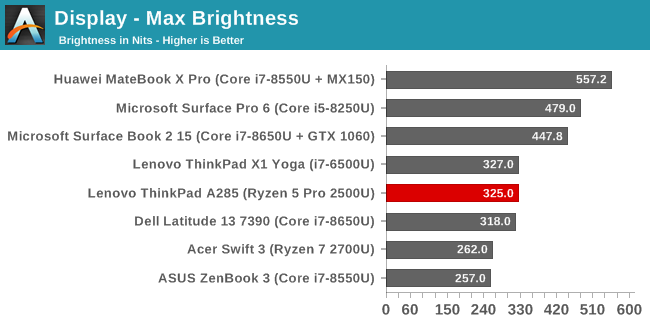
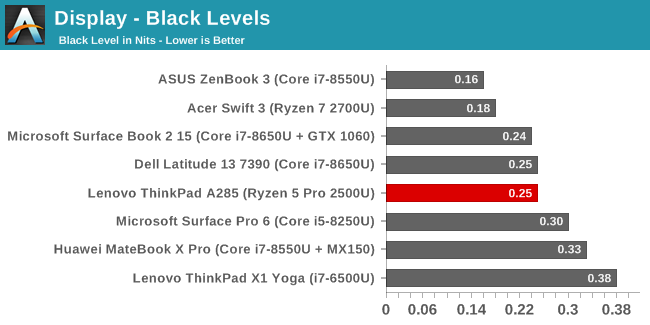
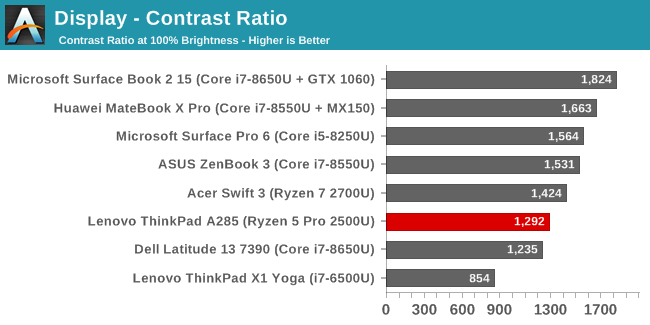
The ThinkPad A285 is rated for 300 nits, and manages to achieve a bit over that at 325. It isn’t the brightest device, but the anti-glare coating should help outdoors. The black levels are quite good though, leading to a decent contrast of almost 1300:1. The brightness also goes down to an impressive 3.4 nits.
Grayscale
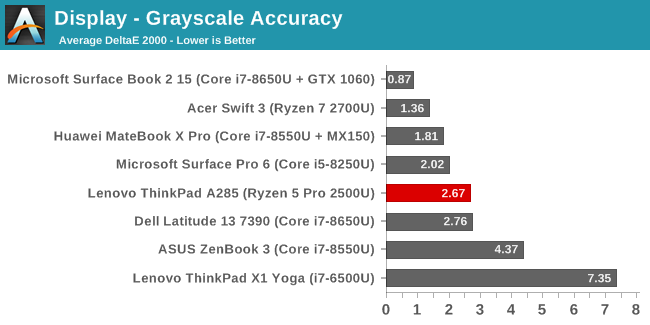
The laptop has a good average grayscale result, although there are definite issues when looking past the averages. The red drops off quite a bit before 100% white, while the blue is too high, leading to a fairly cool display temperature of 7400. The gamma is also too high for most of the range, but then falls off as the brightness gets close to 100%. It isn’t terrible, but it’s pretty average for an IPS panel and clearly there’s no calibration here.
Gamut
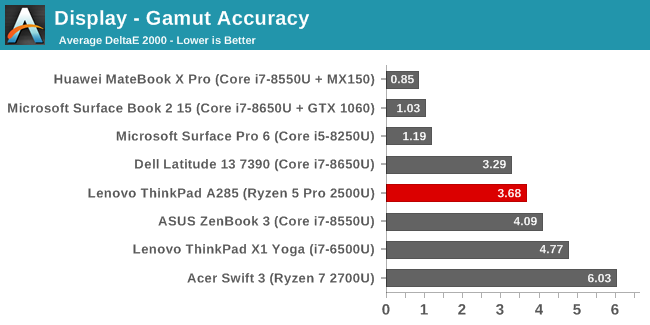
When looking at the sRGB gamut accuracy, we can see that blue is well beyond the correct amount, which pulls magenta off as well. Red is not quite able to hit 100% sRGB, and green is close but slightly out of line.
Saturation
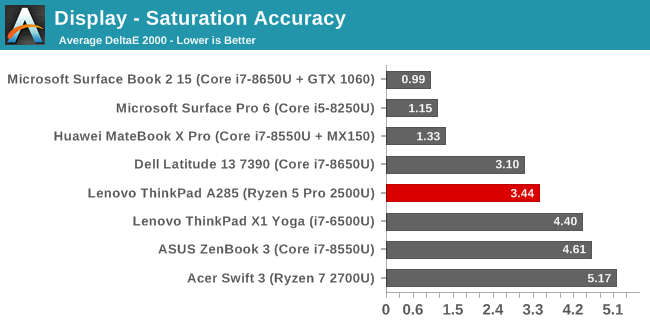
Looking at the 4-bit spaced saturation sweep, you can see that there’s a consistent error level which increases linearly to the 100% levels. None of the colors are in their range, although the average error level isn’t too bad since it’s much closer near the black end of the scale.
Gretag Macbeth
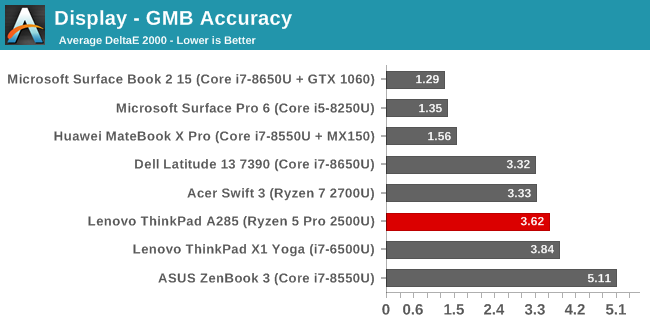
The Gretag Macbeth colorchecker tests various colors, and not just the primary and secondary values. It also includes the important skin tones. As you can see in the graph, there is quite a bit of error on some colors, and others are much closer to where they should be.
Relative Result
This image shows the requested color on the bottom, and the relative result on the top that the display output. The result is relative due to errors in your display, but it does make it fairly clear as to the color drawbacks with this display.
Display Conclusion
The TN option would be better for everyone if it was just gone, so lets just pretend it is. The IPS is very much just a middle of the road display. It offers a good choice in resolution, but it’s not a high-DPI panel. The IPS display offers good off-axis viewing and good contrast levels, but it’s not the brightest around. The color accuracy isn’t great, but it isn’t terrible either. If you’re just doing office tasks, then there’s likely no issues here regardless, and offering the matte coating on a touch display is something that most office workers will appreciate.

















72 Comments
View All Comments
Brett Howse - Tuesday, December 18, 2018 - link
The Surface Book 2 was the device I had power draw numbers from for the idle power draw graph so I have no issues including it in the performance graphs as well. The CPU is a 15W i7. The GPU is of course more powerful but that's still a valid point since people may wonder how close Vega in an iGPU factor is coming to dGPUs.But the best part is that if you don't think it's important, you can just ignore that data point and compare against all the others. Or, click the links I provide to our Online Bench database and make any comparisons you prefer. We provide all the data.
QChronoD - Wednesday, December 19, 2018 - link
I think that many of the people who were complaining about that would accept the comparison if an estimated price of each machine was given at the beginning. If you knew before looking at the graphs that one of the laptops was 2x the price and it looks like being 2x as fast then everything is fine, but if you aren't aware of the price difference then it looks like this machine is a steaming pile.QChronoD - Wednesday, December 19, 2018 - link
Just for reference if anyone actually reads the comments:Microsoft Surface Book 2 15 - $2600
Dell Latitude 13" 2-in-1 7390 - $1800
Asus Zenbook 3 - $1500
Huawei Matebook X Pro - $1350
Lenovo ThinkPad X1 Yoga - $1500
Lenovo ThinkPad A285 - $1200
Microsoft Surface Pro 6 - $1000
Acer Swift 3 R7-2700U - $700
These are just quick prices off amazon trying to get similar specs.
IGTrading - Thursday, December 20, 2018 - link
I agree AnandTech provides "all the data" and that's of course laudable.But often times you can bury a good product in all that data. Comparing a 1200 USD notebook with 2600 USD notebooks is way beyond a stretch.
The potential buyer reading the review for a 1200 USD model is reading it for a reason: because that's what he wants (a 12" portable) or that's his budget (1200 USD) .
Ok ... you compare it with other similar sized notebooks that are also similarly priced ... such as 900 ~ 1400 USD ...
But I honestly have the feeling the results of the Lenovo AMD Ryzen-based notebook are buried in "all the data" ...
Like I've said ... this doesn't look like a review at all and also it doesn't look like a Round-Up (several notebook in a certain price range or with similar characteristics) ..
Going from 700 USD to 2600 USD as a price range ... And from 12" to 15" as a size range ... makes this look like somebody wanted to make the AMD Ryzen portable look slower than a notebook which is much larger and more than 200% more expensive ....
This is how a just comparison should look like in my view (Test Product vs. Similar Products in the Same Product Range vs. 1 product from the Upper Product Range as a comparison example) : https://hothardware.com/ContentImages/Article/2690...
And Ryzen did not beat the CPU+dGPU either ... nor did it ace all the tests ... but I never had the feeling of its results being buried in "all the data" ... just IMHO
kaidenshi - Tuesday, December 18, 2018 - link
Yep, two thin netbooks/ultrabooks I've had in the past had pop-down Ethernet ports, which were the same height as a USB-A port when not in use.thesavvymage - Tuesday, December 18, 2018 - link
honestly though, why do you need an ethernet port on the device? Its kinda just wasting space since its not like you plug that in separately, it should just be connected to whatever dock you have at someone's desk. If I had to plug in power, monitor, and ethernet separately every time I sat at my desk I'd go mad.Right now at work I'm using a macbook and its pretty simple to have all that plugged into a USB-C dock
SaolDan - Wednesday, December 19, 2018 - link
In my line of work i have to be able to connect to lightin controllers and switches thru ethernet out in the field so a Ethernet por would be required.The_Assimilator - Wednesday, December 19, 2018 - link
Not to mention that you have to fork out extra for the dongle!darkich - Tuesday, December 18, 2018 - link
.. a 768p TN entry level screen?Really? My goodness
PeachNCream - Tuesday, December 18, 2018 - link
12.5 inches. At 1080p on that size screen, scaling will be a thing and some software still sucks at scaling. Scaling will also mean that basically the same quantity of information can be displayed at the same time even if the resolution is higher. The GPU will work harder and consume more power while generating more heat to push pixels that do not benefit productivity.